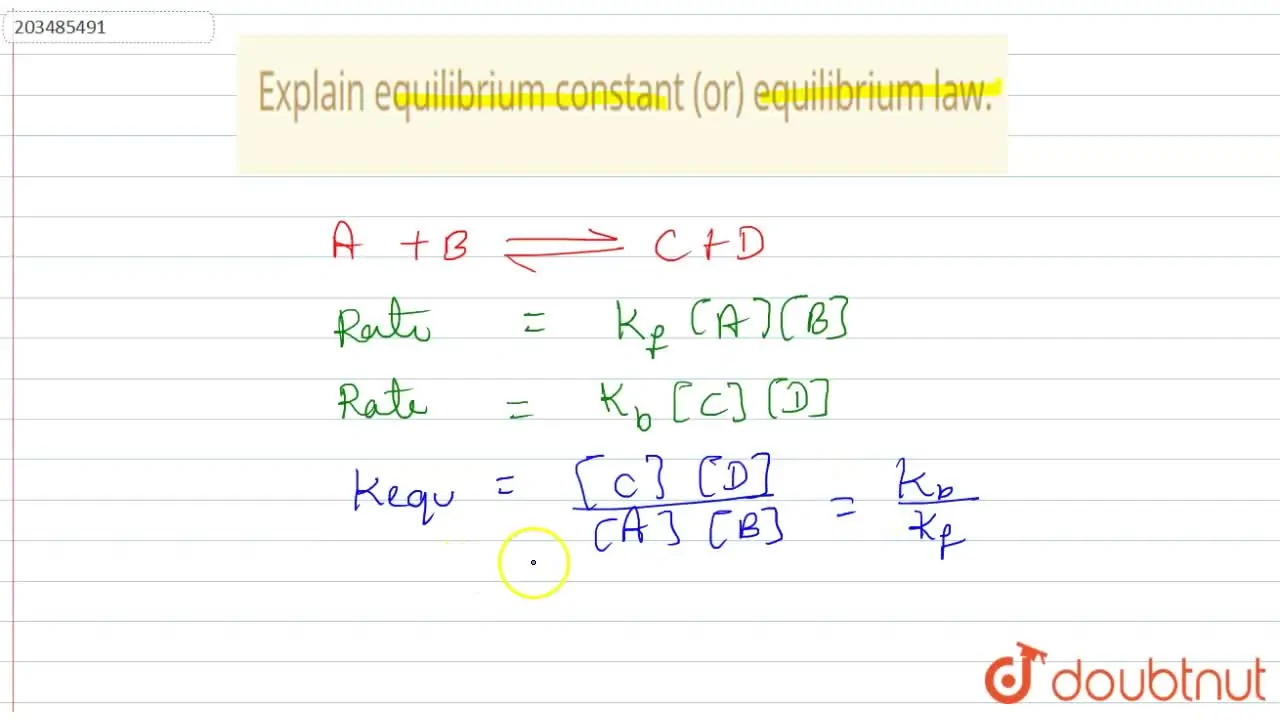Explain equilibrium constant (or) equilibrium law. Solution in Kannada
At any time, rate of the forward reaction is given by the equation V1=K1[A][B]1 where k1 is the rate constant of the forward reaction. Similarly, rate of the backward reaction is given by the equation v2=k2[C][D] where k2 is the rate constant of the backward reaction. At equilibrium, The rate of the forward reaction - the rate of the backward reaction, i.e., v1=v2
k1[A][B]=k2[C][D]
k1k2=Kc=[C][D][A][B] where, Kc is a constant called equilibrium constant.
Kc=k1k2andKc=[C][D][A][B] at equilibrium
This equation is called equilibrium equation.
i.e., in general, for a reaction,
aA+bB⇔cC+dD, the equilibrium equation is Kc=[C]c[D]d[A]a[B]b at equilibrium.
Kc is also known as 'equilibrium constant in terms of molar concentration'. Equilibrium constant is the ratio of the rate constant of the forward reaction to the rate constant of the backward reaction.
Equilibrium constant is the ratio of product of molar concentrations of the products to that of the reactants at equilibrium, the concentrations being raised to the power of the respective number of moles of the species as represented in the balanced chemical equation.
This statement is called "The Law of Chemical Equilibrium" or "Equilibrium Law".
Related Playlists
- BOOK - SUBHASH PUBLICATIONCHAPTER - CHEMICAL EQUILIBRIUMEXERCISE - NUMERICAL PROBLEMS34videos
CHEMICAL EQUILIBRIUM
- BOOK - SUBHASH PUBLICATIONCHAPTER - CHEMICAL EQUILIBRIUMEXERCISE - TWO MARK QUESTIONS AND ANSWERS :60videos
CHEMICAL EQUILIBRIUM
- BOOK - SUBHASH PUBLICATIONCHAPTER - CHEMICAL BONDING AND MOLECULAR STRUCTUREEXERCISE - THREE MARKS QUESTIONS28videos
CHEMICAL BONDING AND MOLECULAR STRUCTURE
- BOOK - SUBHASH PUBLICATIONCHAPTER - CHEMICAL THERMODYNAMICSEXERCISE - Numerical problems :38videos
CHEMICAL THERMODYNAMICS
Similar Questions
The solubility product of AgCl is 2.8×10−10 at 298 K. Calculate the solubility of AgCl in (i) pure water (ii) 0.1M AgNO3 solution, and (iii) 0.1M HCl solution.
15:00View SolutionExplain rate of reaction with its mathematical forms.
01:24View SolutionExplain the formation of Ionic bond in NaCl.
View SolutionCalculate the hest of reaction of the following reaction :
C6H12O6(s)+→6CO2(g)+6H2O(g):ΔH=?04:01View SolutionLaw Of Mass Action And Equilibrium Constant
04:31View SolutionCatalyst have no effect on equilibrium constant. Explain.
09:33View SolutionExplain the relationship between free energy and equilibrium constant.
View Solution"In any reversible reaction, the equilibrium constant for the forward reaction in the reciprocal of the equilibrium constant of the backward reaction"-explain.
View SolutionState the law of chemical equilibrium and explain it.
41:47View SolutionEquilibrium constant is unitless. Explain.
View Solution(i) What is the effect of added inert gas on the reaction at equilibrium. (ii) Explain the equilibrium constants for heterogenous equilibrium.
47:21View SolutionExplain how the equilibrium constant K_(c) predict the extent of a ronction (ii) Explain about the effect of catalyst in an equilibrium reaction?
05:25View SolutionLaw Of Chemical Equilibrium And Equilibrium Constant
View Solution…………… law is used to explain gas-solution equilibrium processes.
View SolutionChemical Equilibrium | Law Of Chemical Equilibrium
View Solution


